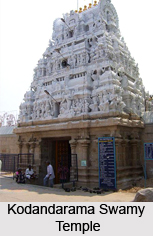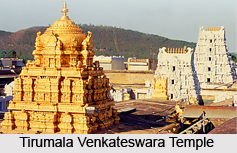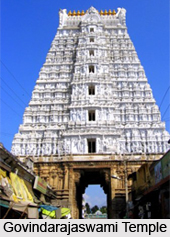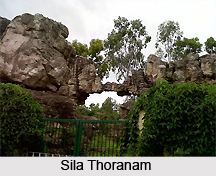 Tirupati City is located in the southeastern part of Andhra Pradesh State. It lies about 152-km northwest of Chennai in the Venkatadri Hills. The abode of the `Kaliyuga` deity Lord Venkateswara, popularly known as Balaji, Tirupati has for centuries remained a destination divine and this is quite evident as one goes round the various temples and spots of natural beauty surrounding this major town. In fact, the government has proposed to give special status to the town on the lines of the Vatican of the East. Lying at the southern tip of the Eastern Ghats in Andhra Pradesh, the district has a number of perennial waterfalls and vast forest cover. About 10-km northwest of Tirupati, at an elevation of 750m, is the sacred hill of Tirumala, which was considered so holy that before 1870 non-Hindus were not permitted to ascend it.
Tirupati City is located in the southeastern part of Andhra Pradesh State. It lies about 152-km northwest of Chennai in the Venkatadri Hills. The abode of the `Kaliyuga` deity Lord Venkateswara, popularly known as Balaji, Tirupati has for centuries remained a destination divine and this is quite evident as one goes round the various temples and spots of natural beauty surrounding this major town. In fact, the government has proposed to give special status to the town on the lines of the Vatican of the East. Lying at the southern tip of the Eastern Ghats in Andhra Pradesh, the district has a number of perennial waterfalls and vast forest cover. About 10-km northwest of Tirupati, at an elevation of 750m, is the sacred hill of Tirumala, which was considered so holy that before 1870 non-Hindus were not permitted to ascend it.
Tirupati was developed mainly by the contributions made by kings during their rule. Almost all the kings from great dynasties of the southern peninsula have paid homage to Lord Sri Venkateswara in this ancient shrine of Tirupati. The Pallavas of Kancheepuram (9th century AD), the Cholas of Thanjavur (a century later), the Pandyas of Madurai, and the kings and chieftains of Vijayanagar (14th - 15th century AD) were devotees of the Lord and they competed with one another in endowing the temple with rich offerings and contributions. During the rule of the Vijayanagar dynasty contributions made to the temple increased enormously. Krishnadevaraya had statues of himself and his consorts installed at the portals of the Tirupati temple, and these statues can be seen to this day. There is also a statue of Venkatapati Raya in the main temple at Tirupati.
After the fall of Hindu kingdoms, came the Muslim rulers of Karnataka and after their downfall the British took over, and many of the temples came under their supervisory and protective control. In 1843 AD, the East India Company divested itself of the direct management of non-Christian places of worship and native religious institutions.
Kodandarama Swamy Temple:
One of the inscriptions in the temple says that Sri Venkateshwara Swamy is incarnation of Sri Rama, and Padmavathi whom he married was at the time of Ramavatara a woman named Vedavati, who was substituted for the real Sita at the time of Ravana`s abduction. It is believed that Narasimharaya Mudiliyar started the temple construction.
The pilasters found on the walls of the garbhagriha and antarala have Vijayanagara capitals. There is a projecting cornice above the wall with its outer surface decorated with Simhalalata gables and its surface cut into compartments by vertical and horizontal rafters. The Vimana is of the ekatala type containing the series: kuta, panjara, sala, panjara and kuta. Above this tala, there is a phalaka containing lions in the Four Corners. The sikhara is round and contains vertical ribbon cuttings and belongs to the vesara order. There is a single metal kalasa above the sikhara. This temple is about 3 km from Tirupati railway station and is well connected by road and there are frequent buses.

Lord Venkateswara Temple:
The temple of Balaji at Tirumala Hills is famous world over and millions of pilgrims from across the globe visit the temple annually. The Pallavas, Pandyas, Cholas, the Vijayanagar rulers and the Maharaja of Mysore patronized the temple, which finds mention in ancient texts. The main temple is an excellent example of South Indian temple architecture. The vimana over the sanctum sanctorum as also the Dhwajasthambam (flag post) are gold plated. The idol of Lord Venkateswara itself is divine to behold and pilgrims are blessed with a sense of complete bliss and satisfaction the moment they glimpse the idol during the `darshan`.
Sila Thoranam:
Situated on the Tirumala Hills, this natural rock formation is one of nature`s wonders and only one of its kinds in Asia, since it is a naturally formed arch of rock. The Sila Thoranam arch is believed to be 1500 million years old and formed by weathering and wind erosion. The length of the arch is 25 feet with a height 10 feet.
The Govindarajaswami Temple:
This Temple is the main attraction for pilgrims at Tirupati and the biggest in town. The earliest of the records belong to the year 1235 AD. The Guruparampara accounts of the Vaishnavas ascribe the foundation of the shrine to Ramanuja. Peculiar features of the temple are that there are two shrines and not one, as usual, in the centre of the innermost enclosure and an outer wall encloses these two. The shrine to the South is that of Krishna, popularly known as Parthasarathi, while the shrine to the North is that of Govindaraja. The Krishna shrine is presently closed for worship. The earliest record found on the innermost gopura belongs to the fifteenth year of the Yadavaraya chief, Viranarasingadeva of 1224 AD. The Govindaraja Swami Temple in Tirupati is situated at a distance of 1 km from Tirupati railway station and 2 km from Tirupati Bus Station.
Vishvaksena Temple, Tirupati
Sri Vishvaksena Temple is located to the north of the main temple, in the Mukkoti Pradakshinam. It occupies an important place in the Vaikhanasa Agama according to Vaishnavite traditions Sri Vishwaksena is worshipped first as the chief of the Lords army and is said to protect every function and rituals from evil. The idol has four hands - the upper two holding a sankha and chakra, the right lower in Avgana hastam, and the left lower on the hip i.e. Gada hastam. During the daily worship of Lord Venkateswara, the garlands and flowers (called nirmalya) from the Lord`s idol are removed and used to worship Vishwaksena.
 Tiruchanur:
Tiruchanur:
Tiruchanur being situated in a plain country, this proxy temple of Sri Venkateshwara attracted large numbers of Pilgrims who came here to pay their homage to the Lord. A Lord Shiva temple, named after Parasareswara, was constructed in the western part of the village (in the present hamlet Jogi-Mallavaram) and it soon grew popular. There was an important Vaishnava settlement at Tiruchanur by the beginning of the Ninth Century.
The Cholas conquered Tondamandalam in which the Tirupati-Tiruchanur area was situated and they were patrons of Shaivism and Shaiva influence reached this erstwhile Vaishnava stronghold of Tiruchanur. Thus, this region came under the influence of Vaishnavism. The Vaishnavas at Tiruchanur established a Tirumantrasalai and carried on proselytising activity. They also constructed a Tiruvilankoil and set up in it an image of Sri Venkateshwara as a representative of the original God of the vedangam hill.
However, the decline of Chola power about the middle of the thirteenth century led to the rise of many local chieftains to independence. Tiruchanur is important for five temples, four of which exist even to this day. These are the Tiruvilankoil, the Krishna temple, The Parasareswara Temple, the Varadaraja temple and the temple of Padmavathi. The Temple is about 5 km from Tirupati railway station. The Temple is well connected by road and there are frequent buses from Tirupati.
Tourist Offices
Regional Tourist Information Bureau
Near T.T.D III Choultry, Tirupati
Tel No: +91 0877 2243306.
Divisional Office, APTDC Ltd.
Near S.V.Bus Station, T.P.Area, Tirupati
Tel No: +91 0877 2255386.
Central Reservation Office, APTDC Ltd.
Near S.V.Bus Station, T.P.Area, Tirupati
Tel No: +91 0877 2255385.

How to reach Tirupati
Air: Direct flights to Tirupati are available from Hyderabad and Chennai only.
Rail: Tirupati is the nearest railway station. There are trains that travel via Renigunta or Gudur, but do not touch Tirupati. In such cases, Renigunta or Gudur, are convenient points to alight. From Renigunta / Gudur one can reach Tirupati by train, bus, or taxi.
Road: APSRTC buses run from all the important places in the state and between Tirupati and Tirumala. TTD also runs buses between Tirupati and Tirumala, free of cost.



















